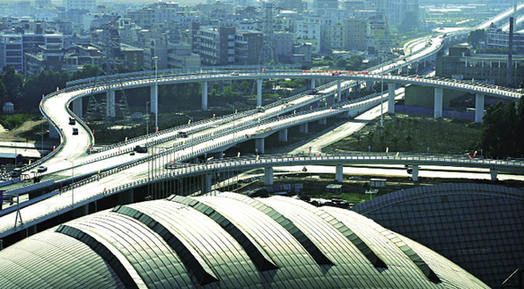Trailblazers for Cross-Straits Exchanges
Trailblazers for Cross-Straits Exchanges
By LIU HUANZHI
TRANSPORTATION is currently the keyword in the economic development of Fujian Province, often juxtaposed with its "twin," the Economic Development Zone on the West Bank of the Taiwan Straits (West Bank Development Zone). The zone has particular significance not only for Fujian Province, but also for the entire country; it plays a special role in mainland-Taiwan exchanges and hopes for the reunification of China.
The construction of the economic zone started with transportation. In early 2004, when the provincial government proposed the West Bank development idea, it set forth the basic principle of "transportation comes first." Since then the provincial transportation department and road builders have functioned as trailblazers for this special regional economic entity, literally laying the foundation for its development and expansion.
 |
|
The Jimei Bridge in Xiamen is 8.43 kilometers long, including 3.82 kilometers that are suspended over the shores of the South China Sea. |
The "Passage" Primacy
Fujian Province on China's southeastern coast faces Taiwan and is adjacent to Hong Kong and Macao. Its geographical location confers an advantage for reaching out to the international market. However, the local geography is hostile to inland communications; the complex terrain of imposing mountains and rolling hills indented by gullies and basins fragments communications among its many cities, towns and villages, while the Meihua, Daiyun and Wuyi mountain ranges block the province's access to its inland neighbors. Five years ago, when local and regional expressways across the country were interconnected into a giant, national traffic web, Fujian was just on the threshold of expressway construction. Meantime, it watched its neighboring Yangtze and Pearl river delta economic zones siphoning outside capital and human resources and growing into the economic powerhouses of the country.
As one of the first provinces opened to the outside world, Fujian was both ashamed and horrified to see the widening gap between it and its developed neighbors and the narrowing of the territory that demarked it from underdeveloped areas. If the situation continued, how much farther would Fujian fall behind in the regional and national economic development drive? How could it fulfill its role in the cause of national reunification? The Fujian people felt the imperative to break out of its isolated condition by opening intra- and inter-provincial passages. In early 2004, the provincial government decided to launch the West Bank Development Zone and commissioned the transportation department to go ahead and open "passages" for it.
In February 2005 Lu Zhangong, then secretary of the CPC Fujian Provincial Committee, summarized the urgency of the "passage" issue. He pointed out that lack of "passages" had been a main obstacle to Fujian's development; "passages" were crucial to activating Fujian's advantages in opening to the outside world, and to the convergence of industries and improvement of people's lives; they were also fundamental to the amelioration of Cross-Straits relations.
When the West Bank Development Zone was promoted into a national development strategy in May 2009, the "passage" issue for Fujian also became a central government concern. In the same month, Premier Wen Jiabao visited Fujian, and when inspecting Xiamen Harbor he pointed out, "The construction of a transport thoroughfare is very important for the West Bank Development Zone. It involves construction of three channels: one, the direct navigation channel from Xiamen and other port cities along the Fujian coast to Taiwan; two, a broad passage network composed of high-speed railways, expressways and air routes that link the entire province to inland areas; and three, the access of Fujian, Xiamen in particular, to the international market." Fujian transportation and the West Bank carry the hopes for the development of the province, now more than ever.
Services
Economy
- Eco-agriculture and Eco-tourism Power Nanchang’s Green Development
- Balance Environmental Protection and Economic Prosperity – Nanchang Looks to European Technology for Green Development
- Sustainable Growth Requires Wiser Energy Use
- Chinese Economy: On the Path of Scientific Development
- China's Economy over the Last Ten Years

